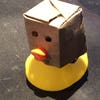First catastrophic nozzle clog!
https://lemmy.sdf.org/pictrs/image/d491c452-61f3-4256-b529-8d4ead72575e.png
https://lemmy.sdf.org/pictrs/image/e272fd60-1eee-4693-8f0d-013230964122.png
Here’s the carnage! Was running a long print and saw this when I went to check on it. Was running the stock Ender 3 hotend with a Capricorn tube fix for nearly 5 years. Served me well. I haven’t yet been able to remove the white PLA. To see the full damage but, I’m pretty sure that the threads are gone.
Guess it’s time to upgrade the hotend.

Add comment